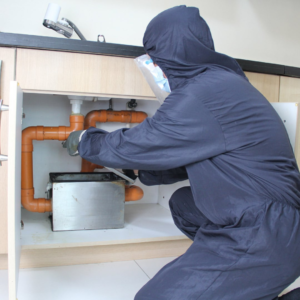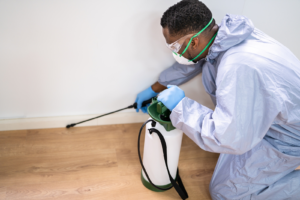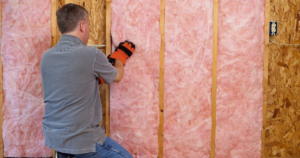If someone in your household has allergies or asthma, the toxin-filled particles circulating in dirty ductwork can exacerbate those conditions. Cleaning the ductwork can eliminate or reduce these allergens.
Clinging odors, such as cooking and pet smells, can also be removed from the ductwork. If rodents have been in the house, their droppings can also be eliminated. Contact Air Duct Cleaning Salt Lake City now!

Air duct cleaning eliminates many harmful contaminants and micro-organisms, including pet dander, dust mites, mildew, mold spores, and other pollutants contributing to poor indoor air quality. These airborne toxins can trigger allergy and asthma symptoms in those with respiratory sensitivities or cause other health problems. A thorough, professional air duct cleaning can make your home healthier for everyone.
When air ducts are uncleaned, bacteria that breed in the dark, moist spaces of ductwork can circulate throughout your house and infect family members with cold and flu-like symptoms. Keeping your ductwork clean can help to keep bacteria and viruses from spreading between household members, especially those with weakened immune systems or other health issues.
Dirty ductwork can also trap odors. From tobacco smoke and cooking smells to paint fumes, cleaning products, and other odor sources, odors can build up, creating and circulating every time your HVAC system runs. A detailed, professional duct cleaning can remove lingering odors and leave your home with a fresher, cleaner scent.
If you suspect your home’s ductwork needs to be cleaned, look for signs of dirty ductwork, like visible dirt and debris, a musty odor, or noticeable mold growth. A visual inspection can also reveal clogged or dirty air vents and registers, a sign of heavy dust accumulation or other debris buildup. You can also check with your health care provider to find out if anyone in your household suffers from indoor allergies, unexplained symptoms or illness that could be linked to irritants or allergens in your home’s air. Whether you have an environmental indicator to go on or you simply want to ensure that your home’s air is as clean as possible, an air duct cleaning performed by a certified, NADCA member contractor can make a difference. To select a contractor, search for NADCA members in your area using the online directory and ask to see proof of their certification and industry experience before agreeing to any services. It’s also important to understand what a professional duct cleaning service involves so you can make an informed decision and avoid being taken advantage of by a dishonest contractor.
Improved Indoor Air Quality
Air duct cleaning is a great way to improve indoor air quality. It can eliminate pollutants that can trigger respiratory and other health problems for family members, especially if they have existing conditions such as asthma or severe allergies. It can also help to prevent mold, which is very toxic and can lead to serious health issues.
In addition, dirty ducts can force the heating and cooling system to work harder, which shortens its lifespan and drives up energy bills. The EPA has found that by having the air ducts cleaned and properly maintained, energy costs can be reduced by as much as 30%.
A dirty ductwork system can harbor allergens like dust mites, pet dander and pollen, as well as dangerous microbes. In addition, it can be a breeding ground for mold and mildew. These contaminants can cause a range of symptoms from allergy and asthma flareups to gastrointestinal upset and more serious respiratory diseases.
During the construction of new homes or renovations, dust and other debris often find their way into the ventilation systems. Since the HVAC system recirculates air five to seven times per day, it can collect this buildup and send it throughout the home.
Duct cleaning can reduce the risk of these contaminants entering your home, and the service providers typically use specialized tools to dislodge and vacuum away the dirt and debris. They also take care to ensure that the ducts are not damaged during the process.
It’s important to find a reputable duct cleaner, and choose one that aligns with the recommendations of industry associations. A certified company will follow best practices, including using specialized tools and applying negative pressure to the ductwork during the cleaning process. This helps to remove contaminants without damaging the ducts and causing them to leak air.
A thorough duct cleaning can eliminate allergens, microbes and other harmful substances that can pose a health hazard to your family. It can also save energy and prolong the life of your heating and cooling system, which will lead to lower electric bills.
Increased Energy Efficiency
Over time, your ductwork can collect sizeable deposits of dust and other contaminants that reduce indoor air quality. If someone in your family suffers from allergies, asthma, or other respiratory conditions, this type of dirt can trigger symptoms and make life uncomfortable at home. Regular duct cleaning removes these harmful substances and keeps them from recirculating in the house.
Dirty ducts also provide an ideal breeding ground for bacteria, mildew, and mold spores, all of which can trigger health issues. Having a clean, hygienic duct system also helps keep other types of allergens and pollutants at bay, such as pet dander, pollen, and household chemicals.
Leaky ducts can cause energy bills to rise because the system must work harder to heat and cool the house. A professional can fix these leaks, which will save energy and help lower utility bills.
Duct cleaning also removes flammable material, such as lint and cotton, from the system. In addition, it eliminates rodent droppings and other pest contamination that may pose a fire risk.
Having your ducts cleaned regularly can also help you identify other problems with your HVAC system, including broken or damaged air filters, which should be replaced as soon as they’re dirty. This will reduce the amount of energy needed to operate your heating and cooling system, and it can increase the lifespan of your units.
The best way to determine whether your ducts need cleaning is by checking their appearance. Look for large deposits of dirt around the air vents and registers, and pay attention to any unexplained odors.
If you notice any of these indicators, you should schedule a duct cleaning appointment right away. Just be sure to give the technician enough time to get to all rooms in your home. It’s also a good idea to keep babies, young children, pets, and important Zoom meetings out of the house during the cleaning process. This will keep them safe and prevent the noises from disturbing them too much. In addition, this will ensure the cleaning team doesn’t miss any areas of your ductwork.
Reduced Health Risks
Air duct cleaning reduces health risks by eliminating dust, dirt, dander, and other pollutants from the circulating air in your home. These contaminants can trigger respiratory conditions such as asthma and allergies. They may also exacerbate existing conditions. Additionally, long-term exposure to these contaminants can lead to fatigue and other symptoms such as headaches and skin issues.
A clean air duct system is also less likely to harbor harmful micro-organisms, such as bacteria, mildew, and germs. These organisms typically thrive in warm, humid environments. They can also infiltrate duct systems through pest infestations or through leaky ductwork joints. Over time, these organisms can contribute to poor indoor air quality by releasing harmful volatile organic compounds into the circulating air.
Fortunately, it doesn’t take much for these pollutants to become trapped in your air ducts. Daily activities generate a variety of substances, such as pet dander, hair, chemicals, and dust, that can quickly build up in your ducts. In addition, pests such as rodents can infiltrate duct systems, leaving droppings and other debris behind. Dirty ducts can also attract moisture and humidity, which can promote mold growth and other fungi.
Once inside your ducts, your HVAC system continually circulates these pollutants throughout your home. This constant circulation of contaminants can aggravate allergies and asthma, as well as cause other respiratory problems, fatigue, headaches, and skin irritation.
In addition, contaminated air can aggravate preexisting medical conditions and lead to premature aging. Studies have shown that breathing in toxins can increase the risk of certain diseases and even lead to heart disease, stroke, and cancer.
Getting regular air duct cleaning is one of the best ways to reduce health risks and improve your home’s indoor air quality. However, it’s important to schedule the service during a time when your family is free from distractions and your pets can stay outside. The service involves loud noises, and your duct cleaners will need to visit every room of your home. It’s also a good idea to arrange childcare or a babysitter during the appointment. In addition, you’ll want to clear a path for your duct cleaners.








